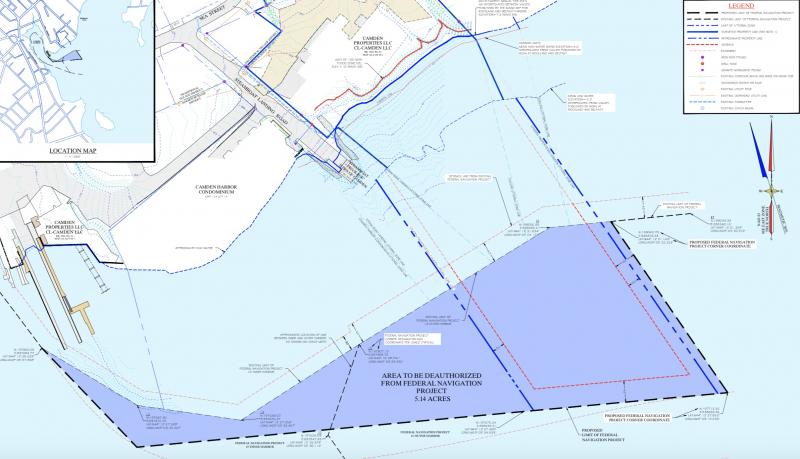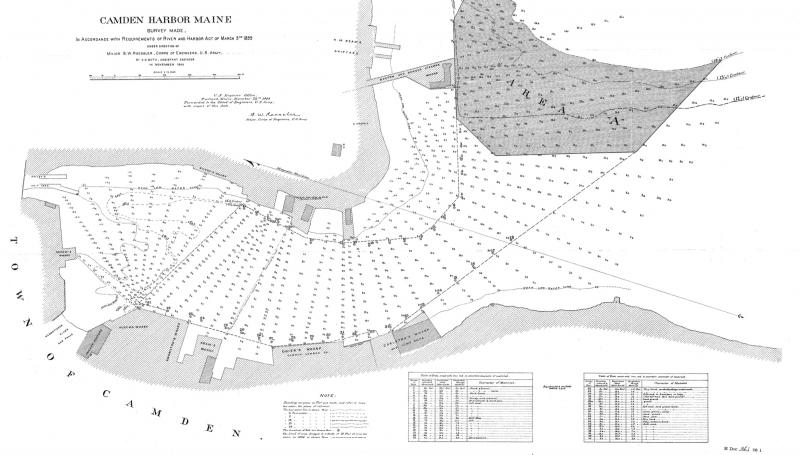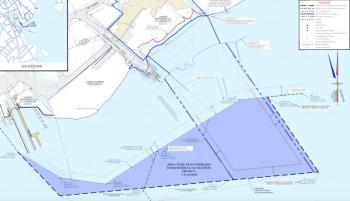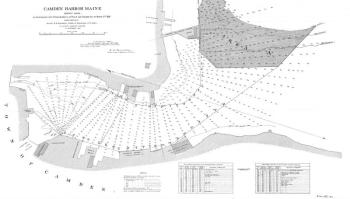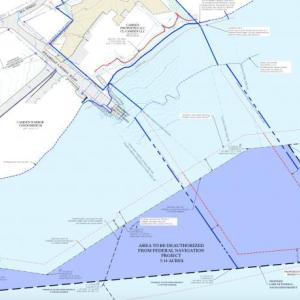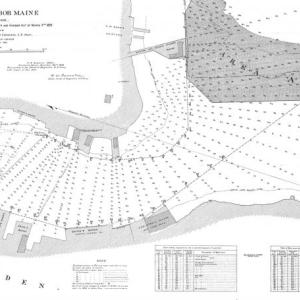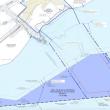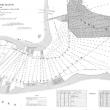Camden debates, then votes to ask Congress to remove harbor section from Army Corps oversight
CAMDEN — Voting 5 to 0, the Camden Select Board has agreed to ask U.S. Congress to deauthorize a 5.14-acre portion of Camden Harbor near Steamboat Landing so the privately-owned Lyman-Morse boatyard can better initiate its marina expansion projects.
While the vote was unanimous, it did not come without debate, with some select board members questioning the process by which Camden considered the Lyman-Morse proposal.
“I remain frustrated by the process,” said Camden Select Board member Alison McKellar, Oct. 23, at a special meeting convened by the board, in the John French Meeting Room at 11 a.m. “I don’t see a reason why it needed to come down to the wire like this.”
While plans for the expansion have yet to be submitted to the Camden Planning Office, the matter came to the board with the initial request for the federal designation change of a portion of the harbor (see map). Deauthorizing the 5.14 acres frees up a portion of the outer (and a sliver of the inner) harbor for redesign and construction of new Lyman-Morse infrastructure, including a pier, a 334-foot wave-attenuating floating dock, and a 579-foot floating dock.
The board held a public discussion about the matter at its Oct. 22 regularly scheduled meeting, and again the next morning to decide on the deauthorization request, when all board members could be present.
According to a memo from Jeremy Martin, Camden’s planner, the goal is to get a portion of the harbor currently under the purview of the U.S. Army Corps of Engineers placed under municipal oversight.
To do so requires the deauthorization to be included in the Congressional Water Resources Development Act 2020, and recorded in the Congressional Register.
The act is not as austere as it sounds; many coastal municipalities in Maine have already deauthorized their harbors in the same way, effectively closing a chapter of American maritime history when the federal government actively dredged waterways and harbors for shipping traffic and shipbuilding, and prohibited infrastructure that impeded marine traffic.
The 1899 Rivers and Harbor Act gave jurisdictional oversight to the Army Corps of navigable waters, but as municipalities along waterways were presented with economic development opportunities that conflicted with the Corps’ navigation maps, they petitioned their Congressional representatives to get their waters, or portions of their waters, deauthorized from the Corps.
Maine harbors that have done so include Rockland, Rockport, East Boothbay, Bass Harbor and many others, according to Martin.
Once the deauthorization occurs, the Army Corps is no longer is responsible for routine dredging of the specified water area, which in this case, is near Steamboat Landing, and has a general low-tide depth of 14 feet.
The last time this particular area was dredged by the Corps was in 1929, said Martin.
According to the Martin memo, circulated Oct. 21 to the select board and Town Manager Audra Caler-Bell, the deauthorization would: “facilitate Lymna-Morse’s marina expansion project that was proposed in 2017 and located near their travel lift. At that time, the Harbor Ordinance was amended via town vote with overwhelming support to facilitate this project. After town approval, the project ultimately was not permitted by the Army Corps as the dock and float system fell within the navigation project area required setbacks.”
He continued that the deauthorization would, “also facilitate Lyman-Morse’s contemplated marina expansion project near the Bean Yard.”
The company received a $1.5 million federal grant last spring for the latter. Read: Lyman Morse receives $1.5 million federal grant to upgrade Camden marina.
The Boating Infrastructure Grant, administered through the U.S. Fish and Wildlife Service, is to be used in partnership with the Maine Department of Transportation to build and install a 120-foot fixed pier, a 334-foot wave-attenuating floating dock, a 579-foot floating dock, and 16 slips for other transient vessels, providing a total of 2,000 linear feet of new dockage for eligible transient boaters.
The deauthorization proposal to the Camden Select Board, however, arrived with an imminent deadline.
According to Martin, the process involves submitting a formal municipal request signed by the select board in order to be included in the Water Resources Development Act 2020, the deadline of which is 5 p.m., Nov. 1.
McKellar argued Oct. 23 that since the town had known about the pending Lyman-Morse plans, there was plenty of time for the public to talk about it.
“There was ample time to involve the Harbor Committee and others in reviewing it, and I don’t understand why we have not done that,” she said, at the Wednesday morning meeting. “For those who are concerned about protecting the harbor from overdevelopment this eliminates a massive layer of protection.”
She said that while the public generally wants to support working waterfronts, but added: “Just turning everything over to local control is not enough. It depends on a very informed public, and a town government that is capable and proactive about informing the people of opportunities for public input.”
She emphasized the need for public notices to be circulated, and said, “If we are not able and willing to go further it can be dangerous.”
Board member Jenna Lookner agreed, saying, “My concern is that the public has not been involved in the process.”
Board member Taylor Benzie said, “Overall, [it is] a net benefit in the long run for us.”
Board member Marc Ratner said: “I can’t change the past. I have to look at the front of this now,” and endorsed the Congressional request.
Chairman Robert Falciani said, “we can always do a better job of everything,” but added that the topic had been on the agenda for five days.
At the Oct. 22 Select Board meeting, the proposal was discussed for an hour with Martin explaining the Congressional process to members. The process requires a request made to a U.S. Senate office, either that of Susan Collins or Angus King.
He noted the downside would be that the Army Corps would no longer dredge the 5.14 acres, if deauthorized. It would be the responsibility of Lyman-Morse to dredge going forward, he added.
Martin also said the next opportunity for changing the designation would not be before 2022. That is because Congress generally considers an omnibus USACE authorization bill every two years, as a Water Resources Development Act.
At the Oct. 22 meeting, Select Board member Jenna Lookner said the time frame was concerning, as well as the need for harbor protection and public participation opportunities.
“I understand that Lyman-Morse didn’t find out about this until two to three weeks ago, that they would have to go through this process, but when you are laying out $10 million for a development project, you have to wonder how this wasn’t a part of things presented earlier on, that this could come to pass, that they would need this from us, so we could educate ourselves.”
Martin responded that there are safety nets, as the Lyman-Morse project undergoes the project review process, to help ensure harbor protection.
McKellar said she appreciated the efforts of Lyman-Morse to work proactively on the waterfront, and that Camden has mechanisms for protecting its public interests, but she warned that the area waters will likely need dredging again.
She added that the boating community should have been drawn into the conversation, specifically concerning water depth.
“If we are going to take on a massive project, we need to have our facts straight,” she said. “And everybody involved has to have a high standard in terms of information that is presented. It will be a better project in the end.”
With the closing vote of Oct. 23, the board voted unanimously to send the de-authorization request to Congress.
Reach Editorial Director Lynda Clancy at lyndaclancy@penbaypilot.com; 207-706-6657
Event Date
Address
United States

